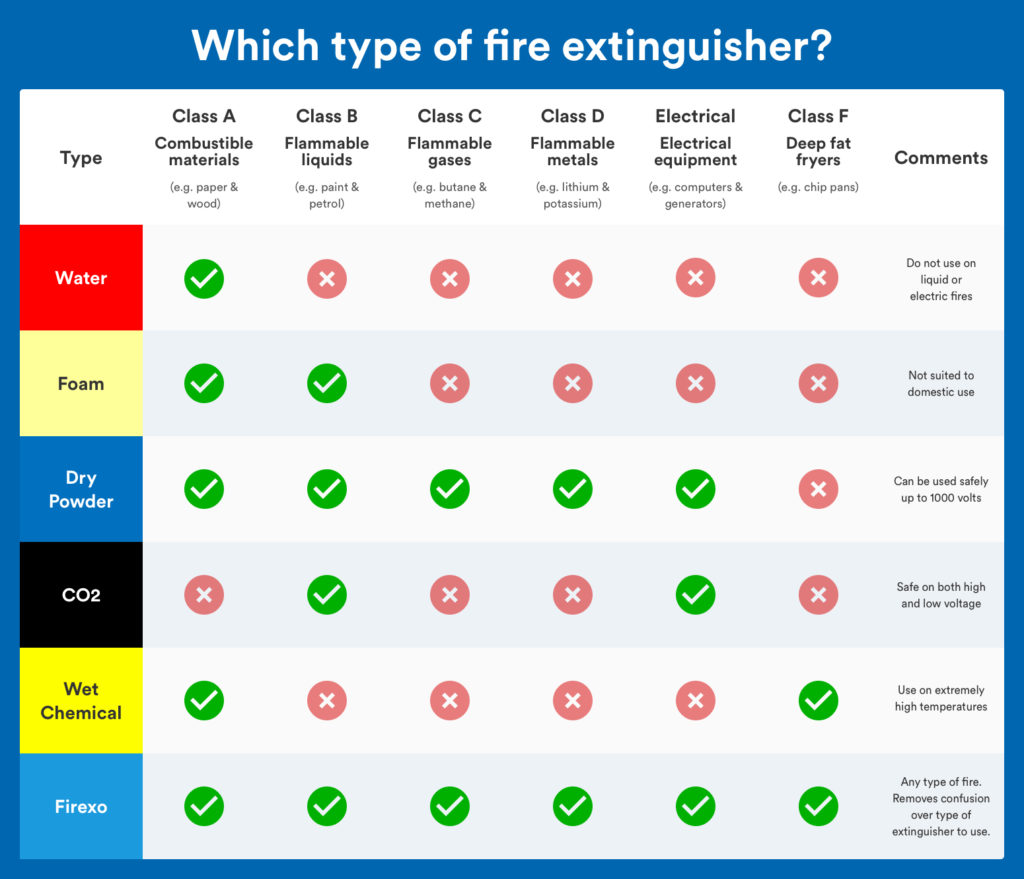Imagine there is a fire and an employee reaches for a fire extinguisher to dampen a fire in order to help them exit a building and it fails to discharge or they use the wrong type of fire extinguisher. The consequences could be catastrophic. Not only could this lead to casualties and fatalities, the resulting fire investigation will undoubtedly uncover these failings and seek to prosecute those responsible.
If you are a building owner, occupier, or an individual with responsibility or fire safety such as a fire warden or responsible individual this could be you and you could be facing a fine or prison sentence.
In this article we explain:
Determining what type of fire extinguisher should be used when a fire breaks out can be a matter of life or death. Using the wrong type of fire extinguisher on certain classes of fire could cause more harm than good and create an even bigger catastrophe.
Providing fire extinguishers in and around your commercial premises is both a safety necessity and a legal requirement, but as we’ve already said, it’s important to do your homework to understand the type of fire that might occur in each area of your commercial premises to ensure the appropriate extinguishers are located nearby and used in the right context.
A further fire safety training measure may include educating your employees on what type of fire extinguisher should be used should a fire break out in their work area and which colour code labelling to look out for. Ensuring they are trained to use a fire extinguisher and have an understanding of the fire triangle may also help ensure fire safety.

What type of fire extinguisher should be used?
Fires fall into one of six classes, depending on which energy source is fuelling them.
As each fire class has its own unique set characteristics several types of fire extinguishers have been developed to safely and effectively tackle each fire class.
Mostly found in offices, schools, hotels and warehouses, water fire extinguishers are used to tackle the fires caused by paper, plastic and fabrics. These are the typical class A fire.
Water extinguishers should NEVER be used on electrical or Class F fires as electrocution or a dangerous oil expansion can occur.
Water Fire Extinguisher labelling is RED
Some water extinguishers produce a continuous jet of water which could cause electrocution to the user if inadvertently sprayed over live electrical equipment – Water spray or water additive extinguishers discharge their contents in a spray mist arrangement. This feature results in the extinguisher being classified as being safe if inadvertently sprayed over live electrical equipment and is backed up by BS and EN standards testing by the manufacturer, usually to 35kv.
Some people get confused between water additive and water mist or water spray. Basically, the water additive is an additive that is added to the water to improve the performance of the contents so you may get the same fire rating from a 3lt water additive as you do from a 6lt water spray. Water additive and water spray usually carry the electrical conductivity test certification due to the spray pattern created by the nozzle and not due to the additive. The problem with water additive is that the additive is a manmade chemical that has long term biodegradable properties and, unlike water, may need special arrangements to dispose of it.
Water additives may often get a higher classification rating than water spray extinguishers but these ratings are obtained by experts in controlled test environments. In the hands of an untrained operator, the quantity of the contents may be a consideration to assist people in exiting a burning building.
Tecserv offers the best of both worlds because all the water extinguishers Tecserv provide are environmentally friendly. They are 100% water with no additives and they have passed the 35kv conductivity test.
When you direct foaming agent onto a fire it creates a barrier between the burning material and the air. This starves the flames of oxygen which suffocates the fire of a fuel source and extinguishes the fire.
Foam fire extinguishers are more versatile than water fire extinguishers as they can be used on both Class A and B (flammable liquids) fires. Foam can also be used to fight electrical fires but it is not recommended as the foam will damage the electrical components.
Foam Fire Extinguisher labelling is YELLOW/CREAM.
In locations where Foam has to be used, Tecserv installs AFFF spray type extinguishers that have passed the 35Kv conductivity test.
Where the contents of foam extinguishers will be compromised by the presence of alcohol-based products or processes, Tecserv will offer advice to clients on alcohol-resistant foam products available.
Dry powder fire extinguishers are the most versatile as they have the ability to tackle the majority of common workplace fires.
Powder Extinguishers are suitable for Class A Fires, Class B fires, Class C fires and fires caused by electrics and faulty electrical appliances. They are not suitable for kitchen fires involving burning liquid such as cooking oils and fats and precaution should always be taken not to inhale the powder.
Powder Extinguishers are not recommended for use in small spaces as the powder can be inhaled.
Powder Fire Extinguisher labelling is BLUE.
CO2 extinguishers use carbon dioxide gas as the fire suppressor and used in areas where electrical equipment is present. Unlike water-based extinguishers, the electricity cannot be conducted via the CO2 gas and electrocute the user.
Should CO2 fire extinguishers be discharged, the user should take extreme care, as when release, the compressed carbon dioxide will be extremely cold and can cause cold burns if sprayed upon naked skin or if the user has to hold onto the extinguisher for a long period.
Breathing difficulties may also be a side effect of discharging a CO2 fire extinguisher, particularly in small spaces, because the CO2 gas reduces the available oxygen in the atmosphere.
IT server rooms are often protected by specialist fire suppression systems.
Carbon Dioxide Fire Extinguisher labelling is BLACK
These are specialised extinguishers for use with fat or oil-based fires often associated with kitchens.
The chemicals in them bond with the ignited oil or fat-producing an emulsion or a cake of soap that starts to cool and extinguish the fire.
Wet Chemical Fire Extinguisher labelling is ORANGE/YELLOW
Firexo
The Firexo fire extinguisher is suitable for all types of fire and removes the confusion over which extinguisher to use.
For safety sake, nobody should ever attempt to extinguish a fire unless in a dire emergency. If you find a fire or are alerted by a fire alarm system and need to evacuate a building, the first response should be to find the nearest fire exit. If however the exit route is blocked, using the right fire extinguisher to create a pathway might be an option to aid escape.
Regulatory Reform (Fire Safety) Order 2005 requires that employees are provided with adequate fire safety training. As part of this, you may choose to train all staff how to use a fire extinguisher.
There are four basic steps to using a fire extinguisher, known as the PASS acronym:
If you should have cause to discharge a fire extinguisher you should always inform the person responsible for fire safety who will arrange for a replacement to be installed.
Fire Extinguisher Maintenance
The recommendation is that all fire extinguishers should be inspected on a monthly basis and documented in a logbook. This inspection can be done by the responsible individual who should check the following aspects to ensure that fire extinguishers are maintained effectively:
Furthermore, the fire extinguisher should be inspected and certified annually by a BAFE Approved fire protection equipment company like Tecserv UK.
Additionally, every five years most fire extinguishers need an extended service. This means completely discharging the extinguisher, checking for internal corrosion, refilling and repressurising.
If you have one of Tecserv UK’s fire extinguisher maintenance packages, our engineer on site will generally take away any expired extinguishers either as part of the servicing agreement.
If you require advice as to what type of fire extinguisher should be used, where they should be located within your work environment or would like to buy additional or replacement fire extinguishers or fire blankets Tecserv has a wide range in stock to suit all applications.

Colin joined Tecserv UK Ltd in 2010. He has been in the fire and security industry for 30 years + and in that time has held a number of senior positions. His experience helps to bring focus and growth to our sales and marketing strategy by being objective driven and KPI measured.